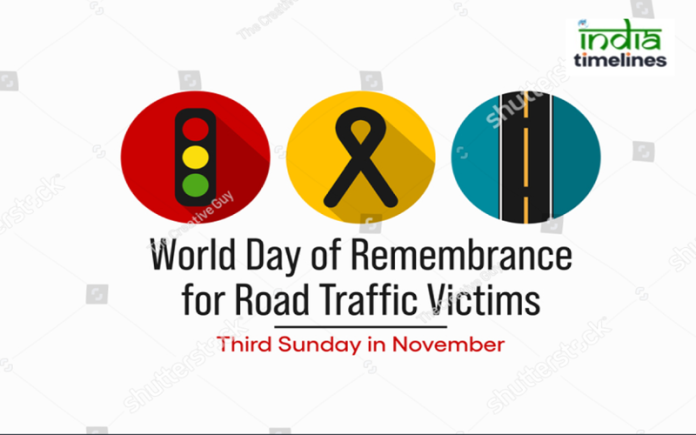
Every year, millions of people worldwide are affected by road traffic accidents, leading to loss of life, injuries, and profound emotional and psychological consequences for families and communities. The World Day of Remembrance for Road Traffic Victims, observed on the third Sunday of November, serves as a poignant reminder of the tragedy that road traffic incidents can inflict and a call to action for improving road safety globally. This day is not just about mourning the dead but also about raising awareness, honoring victims, and advocating for preventive measures to reduce road traffic injuries and fatalities.
History and Significance
The World Day of Remembrance for Road Traffic Victims was established in 2005 by the European Federation of Road Traffic Victims (FEVR) and was later endorsed by the United Nations. The first observance took place in 2006, and it has since grown into a global event, observed in numerous countries around the world.
This day highlights the urgent need for governments, organizations, and individuals to address road safety issues and implement effective measures to prevent road traffic accidents. It acknowledges the pain and suffering endured by victims and their families and emphasizes the importance of comprehensive strategies to enhance road safety.
The Impact of Road Traffic Accidents
Global Statistics
According to the World Health Organization (WHO), approximately 1.3 million people die each year as a result of road traffic accidents, making it one of the leading causes of death globally. An additional 20-50 million people suffer non-fatal injuries, with many facing long-term disabilities. These statistics underscore the immense human and economic toll of road traffic incidents.
Economic Consequences
The economic impact of road traffic accidents is staggering. In addition to the direct costs associated with medical care and emergency response, road traffic injuries result in lost productivity and economic burdens on families and communities. Estimates suggest that road traffic crashes cost countries up to 3% of their gross domestic product (GDP). This loss is particularly acute in low- and middle-income countries, where the burden of road traffic injuries is disproportionately high.
Honoring Victims
On the World Day of Remembrance for Road Traffic Victims, ceremonies and events are held globally to honor those who have lost their lives or been affected by road traffic accidents. These observances provide an opportunity for victims’ families, friends, and communities to come together, share their stories, and support one another in their grief.
Candlelight Vigils
One of the most poignant symbols of remembrance is the candlelight vigil, where participants light candles in memory of victims. These vigils often take place in public spaces, such as parks, town squares, or outside government buildings, allowing communities to unite in their shared loss. The flickering candles serve as a powerful reminder of the lives lost and the need for change in road safety practices.
Raising Awareness and Advocacy
Promoting Road Safety
The World Day of Remembrance for Road Traffic Victims also serves as a platform for advocating road safety initiatives. Governments, NGOs, and community organizations use this day to launch campaigns focused on promoting safe road practices, such as:
- Advocating for stricter laws and regulations regarding speeding, driving under the influence, and seatbelt use.
- Promoting the importance of public transportation and alternative modes of transportation, such as cycling and walking, to reduce reliance on cars.
- Encouraging driver education programs that emphasize safe driving techniques and awareness of road conditions.
International Cooperation
The observance of this day fosters international cooperation and collaboration among countries and organizations to share best practices and successful road safety strategies. Events and discussions held on this day aim to inspire action and drive policy changes at both national and local levels.
The Role of Governments
Governments play a crucial role in enhancing road safety and addressing the challenges posed by road traffic accidents. Effective policy measures can significantly reduce the incidence of road traffic injuries and fatalities. Some essential strategies include:
1. Strengthening Legislation
Implementing and enforcing stringent traffic laws can deter reckless behavior on the roads. This includes:
- Setting appropriate speed limits and enforcing penalties for violations.
- Mandating the use of seatbelts for all passengers and promoting the use of child safety seats.
- Enforcing strict laws against driving under the influence of alcohol or drugs.
2. Improving Infrastructure
Investing in safer road infrastructure is vital for reducing accidents. This includes:
- Designing and maintaining roads that accommodate all types of users, including pedestrians, cyclists, and motorists.
- Installing adequate signage and traffic signals to guide drivers and pedestrians.
- Enhancing lighting in high-traffic areas to improve visibility during nighttime.
3. Implementing Public Awareness Campaigns
Governments can lead public awareness campaigns that educate the public about the importance of safe driving practices. These campaigns can focus on:
- The dangers of distracted driving, including the use of mobile phones while driving.
- The importance of adhering to speed limits and road signs.
- The significance of driver education and training programs.
The Role of NGOs and Community Organizations
Non-governmental organizations (NGOs) and community groups also play a vital role in promoting road safety and supporting victims of road traffic accidents. Their contributions include:
- Providing Support Services: NGOs offer counseling and support services for victims and their families, helping them cope with the emotional and psychological impact of accidents.
- Advocating for Policy Change: These organizations often engage in advocacy efforts to influence government policies and promote road safety initiatives at local and national levels.
- Conducting Research: NGOs may conduct research to better understand the causes and effects of road traffic accidents, providing valuable data that can inform policy decisions and community programs.
The Role of Technology in Road Safety
Advancements in technology are playing an increasingly important role in improving road safety and reducing traffic accidents. Some key technological developments include:
1. Vehicle Safety Features
Modern vehicles are equipped with advanced safety features designed to prevent accidents and protect occupants. These include:
- Anti-lock braking systems (ABS): Help maintain steering control during hard braking.
- Electronic stability control (ESC): Prevents skidding and loss of control during sharp turns.
- Automatic emergency braking (AEB): Detects potential collisions and applies the brakes if the driver does not respond in time.
2. Traffic Management Systems
Smart traffic management systems utilize technology to optimize traffic flow and enhance safety. These systems can include:
- Real-time traffic monitoring: Uses cameras and sensors to track traffic conditions and provide updates to drivers via mobile apps.
- Adaptive traffic signals: Adjusts signal timing based on current traffic patterns to minimize congestion and reduce the likelihood of accidents.
3. Education and Training
Technology is also being used to enhance driver education and training programs. Online courses, simulations, and interactive tools can help drivers develop their skills and awareness of safe driving practices.
Moving Forward: A Collective Responsibility
The World Day of Remembrance for Road Traffic Victims emphasizes that addressing road safety is a collective responsibility that requires the commitment of individuals, communities, governments, and organizations. Here are some actions individuals can take:
1. Practicing Safe Driving
Every driver has a role in ensuring road safety. This includes:
- Avoiding distractions while driving, such as texting or using a phone.
- Obeying speed limits and road signs.
- Never driving under the influence of alcohol or drugs.
2. Advocating for Change
Individuals can advocate for road safety initiatives in their communities by:
- Participating in local road safety campaigns and events.
- Engaging with local authorities to promote infrastructure improvements and stricter traffic laws.
- Sharing their experiences and insights on road safety with others to raise awareness.
India Time Lines
Conclusion
The World Day of Remembrance for Road Traffic Victims is a solemn occasion that calls for reflection, awareness, and action. By honoring the memory of those lost to road traffic accidents, we are reminded of the urgent need to improve road safety and prevent future tragedies. It is a day to unite in grief, advocate for change, and commit to making our roads safer for everyone. Each one of us has a role to play in this vital mission, ensuring that we not only remember the victims but also work toward a future where road traffic accidents are significantly reduced, and lives are preserved. Through collective effort and dedication, we can strive towards a world where safe roads are a reality for all.



































